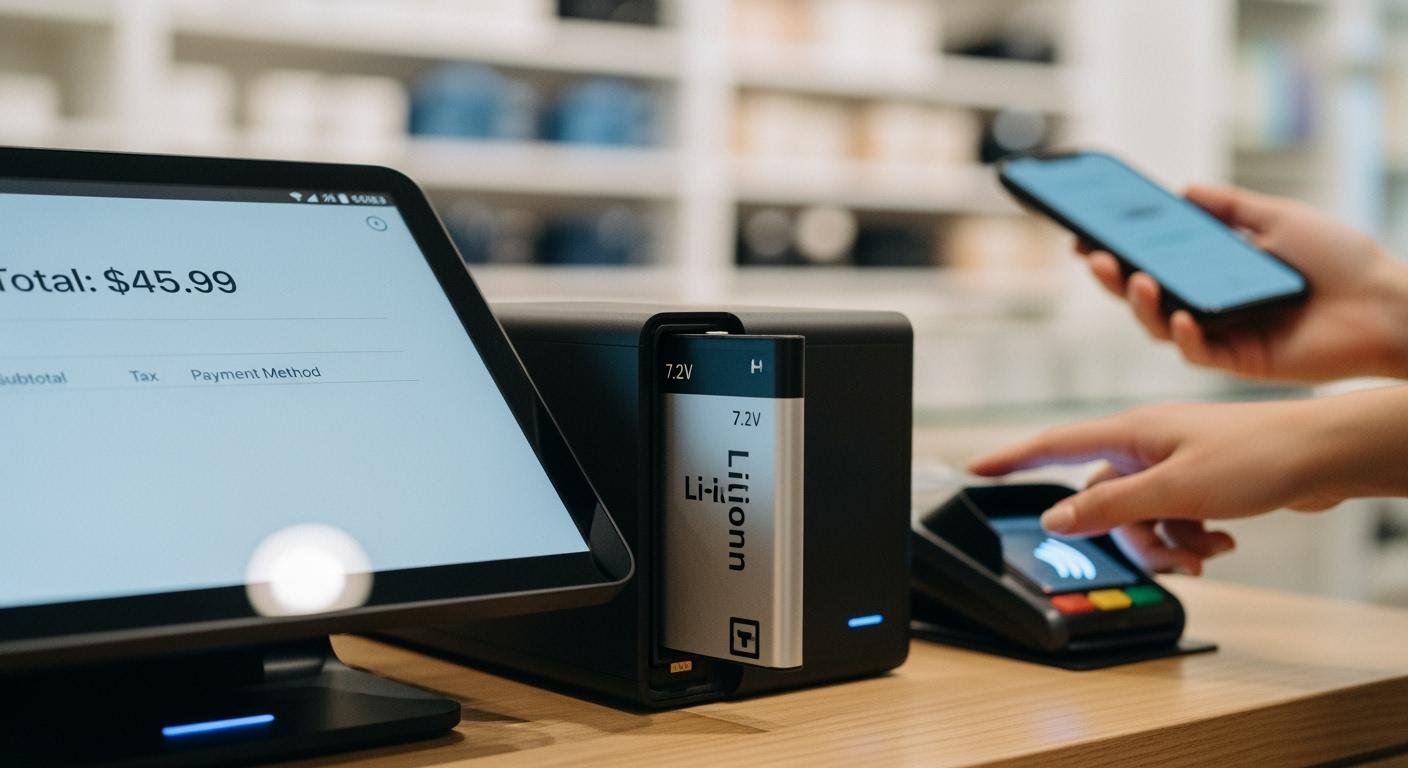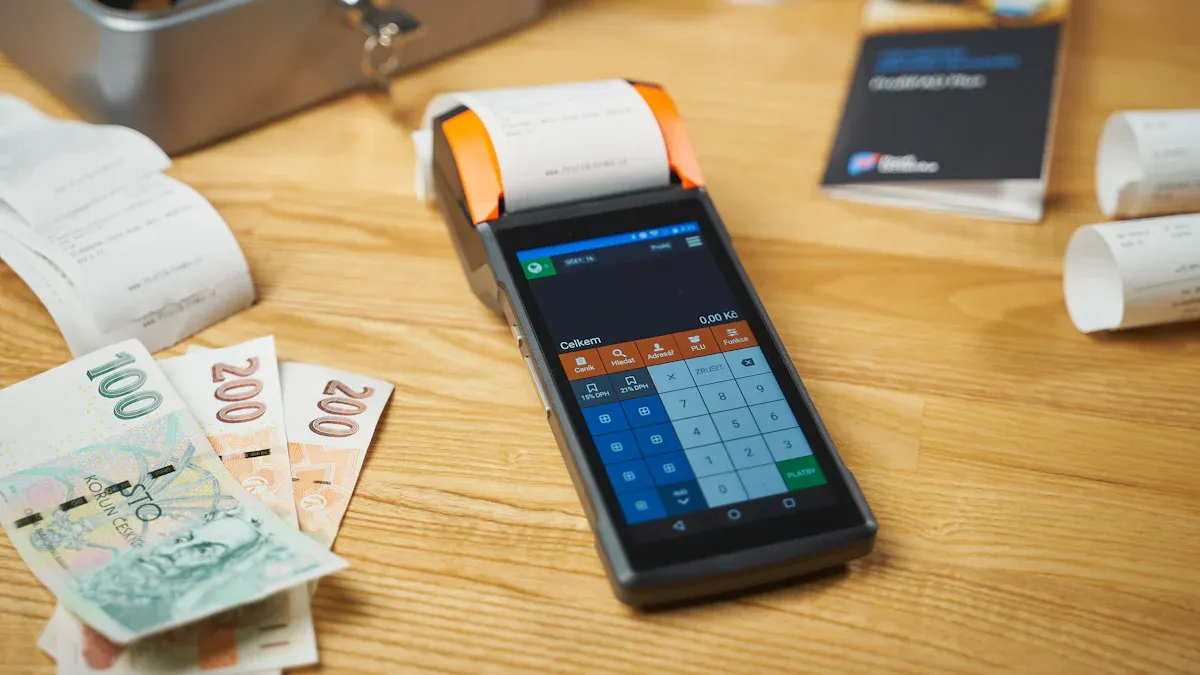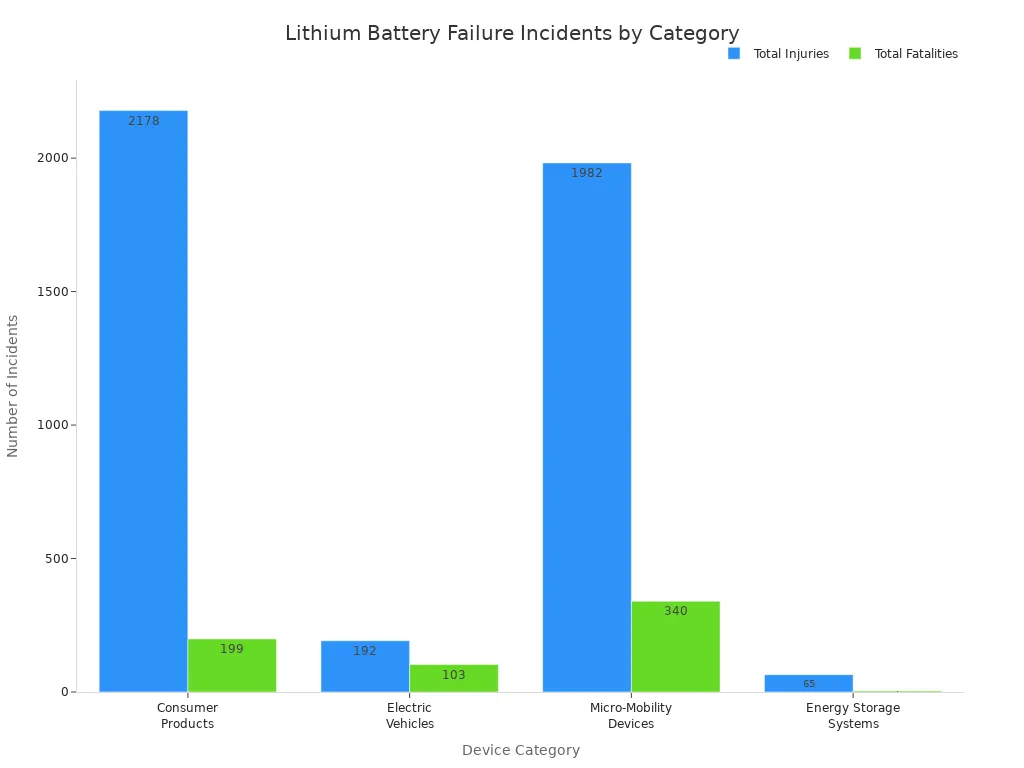
Choosing the right battery ensures your POS terminal runs without interruption. Your smart choice in lithium batteries depends on three key pillars:
- Matching technical specifications.
- Verifying device compatibility.
- Prioritizing advanced safety features.
This structured approach protects your business from mid-day power failures, device damage, and potential safety hazards. Your hardware investment and business continuity remain secure.
Key Specs for POS Lithium Batteries

The technical details on a battery label are not just numbers. They are the language of your device. Understanding them is the first step to choosing a reliable power source. Your primary goal is to match your POS system’s specific battery capacity and voltage requirements.
Match Required Voltage (V)
Think of voltage (V) as electrical pressure. Your POS terminal is designed to operate at a precise pressure. Using a battery with the wrong voltage can cause serious problems.
- Too low voltage: The device may not turn on or will perform poorly.
- Too high voltage: You risk permanently damaging the sensitive internal components of your POS system.
You must match the voltage exactly. Common voltages for POS lithium batteries are 3.7V y 7.4V. While the main power adapter for a POS station might supply 12V to 24V, the internal battery operates at a much lower voltage. For example, different mobile POS models use varying outputs:
- myPOS Mini: 5VDC
- myPOS Combo: 9VDC
- myPOS Smart: 5.0V DC
Action Step: 📝 Always check the label on your original battery or look for the voltage specification in your POS terminal’s user manual. This is the most critical number to match.
Determine Necessary Capacity (mAh)
Capacity, measured in milliamp-hours (mAh), is like the size of your battery’s fuel tank. It tells you how much energy the battery can store and, therefore, how long it can power your POS terminal before needing a recharge.
A higher mAh rating means a longer runtime between charges. For instance, a 2600mAh battery will last longer than a 2200mAh battery. A premier example like an OEM 7.2V 2600mAh battery provides a great balance of voltage and capacity for many systems, ensuring they last through a busy sales day. Choosing the right capacity helps you avoid the frustration of a dead terminal during peak business hours.
Select the Right Chemistry
Not all lithium batteries are created equal. The chemical composition inside determines the battery’s performance, safety, and lifespan. For POS systems, you will generally encounter three main types.
Advancements in battery chemistry have made baterías de iones de litio the top choice for most POS applications. They currently dominate the market, holding an estimated 85% share. This is due to their superior energy density, longer lifespan, and enhanced safety compared to older technologies. Some demanding POS systems need a higher power output, making the right chemistry choice even more important.
Here is a simple breakdown of your options:
| Chemistry Type | Key Advantage | Lo mejor para |
|---|---|---|
| Iones de litio (Li-ion) | High energy density, long cycle life | The majority of modern POS terminals. |
| Lithium-Polymer (Li-Po) | Flexible and lightweight form factor | Slim, compact, or custom-shaped devices. |
| Lithium-Iron Phosphate (LiFePO4) | Excellent safety, very long lifespan | Businesses prioritizing maximum safety and durability over size. |
Continuous research focuses on making lithium-ion batteries even safer and longer-lasting, solidifying their role as the industry standard for reliable business operations.
Finding the Best Battery for POS Systems

Matching technical specs is only half the battle. Finding the best battery for pos systems also requires you to confirm it fits your device perfectly and comes from a trustworthy source. This step ensures your hardware is safe and your investment is protected.
Verify Model and Physical Fit
A battery might have the perfect voltage and capacity, but it is useless if it does not physically fit inside your POS terminal. You must check the battery’s dimensions (length, width, height) and connector type. An incorrect fit can prevent the battery cover from closing or cause a loose connection, leading to power interruptions.
Consejo profesional: 🧐 Look for the battery model number on your original battery. Searching with this number is the easiest way to find an exact replacement.
For example, a common battery for a popular POS model might have the following detailed specifications. You need to ensure your replacement matches these details closely.
| Parámetro | Specification |
|---|---|
| Tensión nominal | 3.7V |
| Capacidad | 2450mAh |
| Dimensions | 5.0mm x 67mm x 61mm |
| Charging Temperature | 10℃ ~ 60℃ |
| Discharging Temperature | -20℃ ~ 65℃ |
| Certificaciones | UN38.3, MSDS, IEC62133, CB, etc. |
Choose OEM vs. Reputable Third-Party
You have two main choices for a replacement battery: Original Equipment Manufacturer (OEM) or a third-party brand.
- OEM Batteries: These are made by the same company that manufactured your POS terminal. They guarantee perfect compatibility but often come at a higher price.
- Third-Party Batteries: These are made by other companies. They are usually more affordable and can offer equal or even better performance.
Choosing the right battery from a third-party source requires careful vetting. A reputable manufacturer demonstrates its commitment to quality through internationally recognized standards. Look for companies that hold certifications for their management and production processes.
| Estándar | Focus Area | Why It Matters for Your Battery |
|---|---|---|
| ISO 9001:2015 | Quality Management | Ensures the battery is made with consistent, high-quality processes. |
| ISO 14001:2015 | Environmental Management | Shows the manufacturer is environmentally responsible. |
| ISO 45001:2018 | Occupational Health & Safety | Protects workers, indicating a well-run and safe facility. |
| ISO 17025 | Testing and Calibration | Guarantees the battery’s performance claims are based on accurate testing. |
Prioritize Advanced Safety Features
Safety should be your top priority. Faulty lithium batteries can pose serious risks. In fact, over half of businesses have experienced incidents like overheating or smoking from these batteries, with some even reporting fires or explosions.

To protect your business, look for batteries with two key safety components: a modern Sistema de gestión de baterías (BMS) and proper safety certifications.
A sistema de gestión de baterías is a small electronic circuit inside the battery pack. It acts as the battery’s brain, protecting it from common dangers.
- Overcharge Protection: The BMS monitors cell voltage during charging. It cuts off power if the voltage gets too high, preventing overheating and damage.
- Short-Circuit Protection: If a short circuit occurs, the BMS instantly disconnects the current flow in microseconds. This action protects both the battery and your POS terminal.
Additionally, you should always verify that a battery has key safety certifications. These marks show that the battery has passed rigorous independent testing. IEC 62133 is the most important international standard for the safety of rechargeable batteries in portable devices like POS terminals. It covers tests for overcharging, short-circuiting, and thermal stability to ensure product safety and build consumer trust.
| Certificación | Descripción |
|---|---|
| IEC 62133 | International safety standard for portable rechargeable batteries. |
| UL | Tests for safety against fire, electric shock, and other hazards. |
| Marcado CE | Declares conformity with health and safety standards in the European Union. |
| UN 38.3 | Ensures safety during transportation of lithium batteries. |
Check Warranty and Support
A good warranty is a sign of a manufacturer’s confidence in its product. It protects you from defects and premature failure. Before you buy, always check the warranty period and understand what it covers.
OEM and third-party warranties often have different structures.
- OEM Batteries: These typically offer a free replacement period of around 12 months. After that, they may offer pro-rated coverage for up to 48 months, where you pay a percentage of the cost for a replacement.
- Third-Party Batteries: Reputable aftermarket brands often provide a 1- to 3-year free replacement warranty. Premium options may even match or exceed the total coverage of OEM warranties.
A longer, more comprehensive warranty provides peace of mind and better value for your investment. Also, check if the seller offers accessible customer support in case you have questions or need to process a warranty claim.
How to Maximize Battery Lifespan
You can extend the life of your POS battery with a few simple practices. Proper care ensures you get the most value from your investment. Following these habits helps maintain battery health and reliability for your daily operations.
Implement Proper Charging Habits
Your charging routine directly impacts your battery’s health. For lithium-ion batteries, regular partial charging is better than running the battery down to 0% and then charging it to 100%. Each full charge and discharge, known as a charge cycle, slightly reduces the battery’s capacity. A quality battery offers a long cycle life, but smart habits can extend it even further.
Many people wonder if leaving a POS terminal plugged in overnight is safe. Modern devices have built-in protection that stops charging at 100%. The system then runs on AC power. However, heat is the real danger.
Action Step: 🔌 If you charge your device overnight, make sure it is in the open air. Never cover it or place it in a tight space where heat can build up and damage the battery.
Follow Optimal Storage Conditions
You may need to store spare batteries or take a terminal out of service. Proper storage conditions protect the battery’s chemical integrity. You should store lithium batteries in a cool environment and at a partial charge.
| Factor de almacenamiento | Optimal Condition | Por qué es importante |
|---|---|---|
| Temperatura | 59°F (15°C) | Cool temperatures slow down chemical degradation. |
| Estado de carga | 40% to 60% | This range prevents damage from high voltage or deep discharge. |
Storing a battery fully charged or completely empty for long periods can cause permanent capacity loss.
Conduct Regular Physical Inspections
Regularly checking your battery is key for maximizing battery performance and ensuring safety. At least once a month, remove the battery and look for any signs of trouble. You should replace the battery immediately if you see any of these issues:
- The battery case is swollen or bulging.
- There are signs of leaking fluid or corrosion on the contacts.
- The terminal shuts down unexpectedly or will not hold a charge.
When you replace a battery, remember to dispose of the old one responsibly. Most lithium batteries are classified as hazardous waste. You should take them to a designated e-waste or battery recycling center instead of throwing them in the trash.
Choosing the right battery follows a simple, three-step method. You begin by matching key specs like voltage and chemistry. Then, you confirm the physical fit and select a trustworthy supplier. Finally, you verify the safety features and warranty. This structured approach is your key to ensuring POS system reliability and operational safety.
Your careful choice in lithium batteries protects your hardware investment and secures your business continuity.
PREGUNTAS FRECUENTES
How often should you replace a POS battery?
You should replace your battery every 2 to 3 years. Most lithium batteries last for 300 to 500 charge cycles. You will notice a shorter runtime when the battery nears the end of its life. This is a clear sign you need a replacement.
Can you use a battery with a higher mAh?
Yes, you can use a battery with a higher mAh rating. A higher capacity provides a longer runtime for your POS terminal. You must ensure the voltage and physical dimensions still match your device perfectly.
Important Note: 💡 Never use a battery with a different voltage. It can permanently damage your POS system.
Is it safe to leave a POS terminal plugged in?
Modern POS terminals have safety features to prevent overcharging. It is generally safe to leave them plugged in. However, you should always ensure the device has good airflow. Heat buildup can reduce the battery’s lifespan over time.
What does “cycle life” mean for a battery?
Cycle life tells you how many full charge and discharge cycles a battery can handle before its capacity drops significantly. A battery with a 500-cycle life can be fully charged and drained 500 times. 👍 A higher cycle life means a longer-lasting battery.

